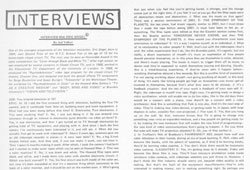A Kinetic History: The EAI Archives Online
A Kinetic History: The EAI Archives Online
Eric Siegel's Video Synthesizers
In the early 1970s, artists played a significant role in shaping the language of the video medium through the development of new electronic imaging tools. Shortly after showing his Psychedelevision in Color in the "TV as a Creative Medium" exhibition at the Howard Wise Gallery in 1969, artist/engineer Eric Siegel, with assistance from Wise, began to develop two new video synthesizers. The first, the Processing Chrominance Synthesizer (Video Color Synthesizer), allowed users to manipulate color signals created from black and white input. The second, the Electronic Video Synthesizer (EVS), contained a series of color and pattern generators, enabling the mixing and abstraction of a video signal. Over the next three years, Siegel designed and built the two devices while Wise procured funds and acted as an agent on his behalf. Patents were obtained for each synthesizer, and a for-profit organization, Electronic Visions, Inc., was established for their promotion. While widespread sales never materialized, Siegel's goals were primarily artistic: "The technology was a means to an end," he writes, "not the destination."


